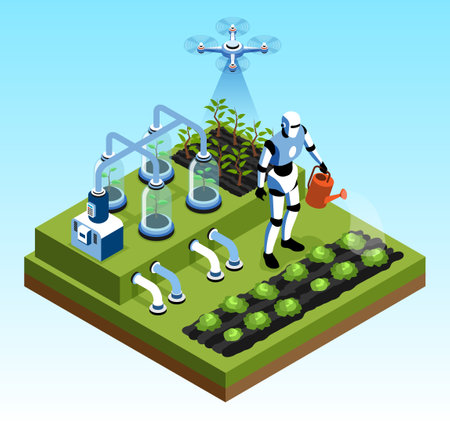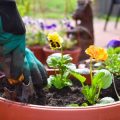Introduction to Sustainable Gardening
In recent years, more and more American households are turning to sustainable gardening as a way to live greener and healthier lives. Whether you’re tending to a backyard veggie patch in Oregon or keeping houseplants thriving in a New York apartment, eco-friendly gardening is about making choices that are good for both your home and the planet. With climate change, water shortages, and pollution on the rise, embracing sustainable gardening practices is no longer just trendy—its essential.
Sustainable gardening focuses on working with nature instead of against it. It means using smart tools, conserving resources like water and energy, reducing waste, and avoiding harmful chemicals. Eco-friendly smart gardening tools make this easier than ever by helping you garden efficiently while reducing your environmental footprint.
Why Sustainable Gardening Matters
Sustainable gardening offers a wide range of benefits—not only for the environment but also for your health and wallet. Here’s a quick look at why it matters:
| Benefit | Description |
|---|---|
| Environmental Impact | Reduces pollution, conserves natural resources, and supports biodiversity. |
| Cost Savings | Smart watering systems and composting reduce utility bills and waste disposal costs. |
| Healthier Living | Fewer chemicals mean safer food and cleaner air around your home. |
| Resilience | Diverse, low-maintenance gardens are better equipped to handle droughts or pests naturally. |
Core Principles of Eco-Friendly Gardening
If youre new to sustainable gardening, here are some guiding principles to get started:
- Conserve Water: Use rain barrels, drip irrigation systems, and drought-tolerant plants.
- Minimize Waste: Compost kitchen scraps and yard waste instead of sending them to landfills.
- Avoid Chemicals: Choose organic fertilizers and natural pest control methods.
- Use Smart Tools: Invest in energy-efficient devices like solar-powered garden lights or app-controlled irrigation timers.
- Grow Native Plants: They require less maintenance, water, and are more resilient to local pests.
The Role of Smart Gardening Tools
Technology is making sustainable gardening more accessible than ever. Smart tools like soil sensors, automated irrigation systems, and weather-based controllers help you make informed decisions about how and when to water or fertilize your plants. These tools not only save time but also ensure that resources are used wisely—helping you grow a beautiful garden that supports a healthier planet.
2. Benefits of Smart Gardening Tools
Smart gardening tools are transforming the way we care for our gardens, especially for those looking to maintain an eco-friendly and sustainable home. These innovative tools not only make gardening more efficient but also help reduce our environmental footprint. Here are some key benefits of using smart gardening tools:
Water Conservation
One of the standout advantages of smart gardening tools is their ability to conserve water. Devices like smart irrigation systems and soil moisture sensors ensure that your plants receive just the right amount of water—no more, no less. This means less water waste and lower utility bills, all while keeping your garden healthy.
Common Water-Saving Smart Tools
| Tool | Main Feature | Eco Benefit |
|---|---|---|
| Smart Irrigation Controller | Schedules watering based on weather and soil data | Reduces overwatering and saves water |
| Soil Moisture Sensor | Monitors soil hydration levels | Prevents unnecessary watering |
| Rain Sensors | Pauses irrigation during rainfall | Avoids redundant watering |
Time Efficiency
If you’re juggling work, family, and other responsibilities, smart gardening tools can be a real time-saver. Automated systems allow you to monitor and control your garden remotely using your smartphone or tablet. From setting up watering schedules to receiving alerts about plant health, these tools help you manage your garden with minimal effort.
Examples of Time-Saving Tools
- Smart Plant Monitors: Track light, temperature, and humidity in real-time.
- Robotic Lawn Mowers: Automatically trim your lawn without supervision.
- App-Controlled Grow Lights: Set lighting schedules for indoor plants remotely.
Reduced Environmental Impact
By optimizing how we use resources like water, energy, and fertilizers, smart gardening tools contribute to a healthier planet. Many of these devices are designed with sustainability in mind—using solar power, reducing chemical usage, and promoting organic growth practices.
Sustainability Features at a Glance
| Feature | Description | Environmental Benefit |
|---|---|---|
| Solar-Powered Devices | No need for batteries or electricity | Lowers carbon footprint |
| Nutrient Monitoring Systems | Optimize fertilizer use based on plant needs | Reduces chemical runoff into the environment |
| Sustainable Materials | Bamboo, recycled plastics, biodegradable components | Lessen landfill waste and resource consumption |
The integration of technology into gardening isnt just a trend—it’s a meaningful shift toward smarter, greener living. Whether youre conserving water during dry spells or cutting down on yard maintenance time, these tools help create a more sustainable lifestyle that aligns with both modern convenience and environmental responsibility.

3. Top Eco-Friendly Smart Gardening Tools
If youre looking to make your home garden more sustainable while keeping things high-tech and easy to manage, eco-friendly smart gardening tools are the way to go. These devices help reduce waste, save water, and lower your carbon footprint—all while giving your plants the care they need. Let’s take a look at some of the top smart tools designed for green-thumbed homeowners.
Solar-Powered Irrigation Systems
Watering your garden can be one of the most resource-intensive tasks, especially during hot summer months. Solar-powered irrigation systems use energy from the sun to pump water directly to your plants, reducing electricity usage and water waste. Many models come with smart timers or sensors that adjust watering schedules based on weather conditions.
Benefits:
- No electrical wiring needed—fully solar powered
- Automatically adjusts watering times based on sunlight and soil moisture
- Ideal for remote areas or off-grid gardening
App-Controlled Soil Sensors
Knowing exactly when and how much to water can be tricky. App-controlled soil sensors make it easy by measuring moisture levels, temperature, and even nutrient content. These sensors send real-time updates to your smartphone so you can make informed decisions about your plant care routines.
Popular Features:
| Feature | Benefit |
|---|---|
| Moisture Detection | Prevents over- or under-watering |
| Nutrient Tracking | Helps optimize fertilization schedules |
| App Notifications | Sends alerts directly to your phone |
Smart Composting Devices
Turning kitchen scraps into nutrient-rich compost has never been easier with smart composters. These compact devices are designed for indoor or outdoor use and speed up the composting process using sensors and automated mixing. Some even connect to apps that tell you when the compost is ready or if it needs more browns or greens.
Why Choose a Smart Composter?
- Cuts down on food waste by turning scraps into useful soil
- No guesswork—automated tracking and maintenance tips via app
- Odor control features make them ideal for use inside the home
Summary of Smart Gardening Tool Benefits:
| Tool Type | Main Eco-Friendly Benefit | Smart Feature |
|---|---|---|
| Solar Irrigation System | Saves water and energy | Sun-powered automatic watering schedule |
| Soil Sensor | Reduces water waste and improves plant health | Real-time app updates on soil conditions |
| Smart Composter | Lowers landfill waste and produces organic fertilizer | Sensors + app guidance for optimal composting |
The future of sustainable gardening lies in combining eco-conscious practices with modern technology. With these tools in hand, taking care of your garden becomes smarter, greener, and easier than ever.
4. Incorporating Tech into Your Garden Routine
Bringing smart technology into your gardening routine is a great way to save time, reduce waste, and support a more eco-friendly lifestyle. Whether you’re a beginner or a seasoned gardener, today’s smart gardening tools make it easier than ever to grow a lush, sustainable garden with less effort and more efficiency.
Start Small with Smart Sensors
Smart soil moisture sensors are an easy entry point. These devices monitor the moisture level in your soil and send alerts to your phone when its time to water. This helps prevent overwatering—a common issue that wastes water and harms plants.
Benefits of Using Smart Soil Sensors
| Feature | Benefit |
|---|---|
| Real-time data | Know exactly when your plants need water |
| Mobile alerts | Get reminders on your phone or tablet |
| Water conservation | Reduce water usage by avoiding overwatering |
Automate with Smart Irrigation Systems
A smart irrigation system connects to your home Wi-Fi and automatically adjusts watering schedules based on local weather forecasts and soil conditions. This ensures your plants get just the right amount of water without wasting any.
Popular Smart Irrigation Features
- Weather-based scheduling
- Zone-specific watering control
- Integration with voice assistants like Alexa or Google Home
- Remote access via smartphone apps
Add Smart Lighting for Indoor Gardening
If youre growing herbs or vegetables indoors, smart grow lights can provide optimal lighting conditions throughout the day. These lights can be scheduled or controlled remotely, ensuring your plants receive consistent light even when youre not home.
Tip:
Look for LED grow lights labeled as energy-efficient to stay true to your eco-friendly goals.
Use Garden Planning Apps for Efficient Layouts
Garden planning apps help you design efficient layouts, track plant growth, and remind you of planting dates. Many apps are tailored for U.S. regions, making it easier to follow seasonal guides that match your climate zone.
Recommended Apps for Smart Gardening
| App Name | Main Feature | Best For |
|---|---|---|
| From Seed to Spoon | Plant tracking & growing tips | Home vegetable gardens |
| Planter App | Visual garden layout tool | Raised bed planning |
| Bloom Calendar by Monrovia® | Seasonal planting reminders | Shrubs & flowers enthusiasts |
Create Eco-Friendly Routines with Automation
The key to low-impact gardening is consistency. By automating tasks like watering and lighting, you reduce resource waste while making it easier to care for your garden regularly—even during busy weeks.
Quick Tip:
Create routines using smart plugs and timers to control compost turners, greenhouse fans, or rainwater pumps. Every bit of automation adds up to a greener lifestyle.
The integration of technology doesn’t have to be overwhelming. Start with one smart tool at a time, and as you see the benefits—both for your garden and the environment—you’ll find yourself naturally expanding into more sustainable gardening habits.
5. Choosing the Right Tools for Your Home Garden
When it comes to eco-friendly smart gardening, selecting the right tools can make all the difference. Whether youre growing herbs on a balcony or managing a full backyard garden, your tool choices should reflect your space, local climate, and sustainability goals.
Consider Your Garden Size
The size of your garden determines not only how many tools you need but also the type. Smart gardening tools come in various sizes and capabilities, so matching them to your space helps avoid unnecessary energy use and cost.
| Garden Size | Recommended Smart Tools |
|---|---|
| Small (Balcony/Patio) | Smart planters, compact soil sensors, app-controlled watering systems |
| Medium (Urban Backyard) | Solar-powered irrigation kits, weather-adaptive sprinklers, Wi-Fi plant monitors |
| Large (Suburban/Rural) | Smart weather stations, robotic lawn mowers, automated composters |
Match Tools to Your Climate Zone
The U.S. is divided into multiple climate zones, from arid deserts to humid subtropics. Choosing tools that adapt to your local environment helps improve efficiency and reduce waste.
Climate-Specific Tool Tips:
- Cold Zones (e.g., USDA Zones 3-6): Choose frost-resistant sensors and winter-ready solar panels.
- Hot & Dry Zones (e.g., USDA Zones 8-10 Southwest): Look for drip irrigation systems with moisture sensors to conserve water.
- Humid Zones (e.g., USDA Zones 7-9 Southeast): Use mildew-resistant smart planters and rain-sensing watering timers.
Align with Your Sustainability Goals
Your personal eco-goals should guide your tool selection. Some gardeners focus on water conservation, while others prioritize reducing energy use or minimizing waste.
Sustainability Goals & Tool Match:
| Sustainability Goal | Best Tool Types |
|---|---|
| Reduce Water Usage | Soil moisture sensors, drip irrigation systems with timers |
| Lower Energy Consumption | Solar-powered garden lights and tools, manual smart tools with data-tracking features |
| Minimize Waste | Smart composters, app-connected garden planners for optimized planting |
A Few Extra Tips
- Check if the tool integrates with your smartphone or smart home system for easy monitoring.
- Look for products certified by ENERGY STAR or made from recycled materials.
- Select tools with modular parts so you can repair instead of replace when needed.
Selecting the right eco-friendly smart gardening tools tailored to your specific needs ensures youre not only gardening efficiently but also responsibly. By considering garden size, climate zone, and personal sustainability goals, youll create a more productive and earth-friendly outdoor space.
6. Maintaining Sustainability Year-Round
Keeping your smart garden eco-friendly all year long doesn’t have to be complicated. With a few seasonal strategies and reminders, you can ensure that your garden tools and routines stay efficient and environmentally responsible—no matter the weather. Heres how to keep your sustainable gardening habits on track throughout the seasons.
Spring: Kickstart with Smart Planning
Spring is the perfect time to prepare your garden for success. Use smart sensors and soil monitors to test moisture and nutrient levels before planting. This avoids over-watering and unnecessary fertilizing. Choose native plants that thrive in your region to reduce water use and support local ecosystems.
Tips for Spring:
- Calibrate your smart irrigation system based on real-time weather data.
- Use compost from kitchen scraps as natural fertilizer.
- Install solar-powered garden lights or smart devices to reduce energy use.
Summer: Maximize Efficiency
During the hotter months, its essential to manage water usage and plant health efficiently. Smart drip irrigation systems can deliver water directly to roots, minimizing evaporation. Many smart gardening apps offer alerts for drought conditions or pests.
Tips for Summer:
- Water early in the morning or late in the evening using automated timers.
- Check sensor data weekly to adjust watering schedules.
- Use mulch to retain soil moisture naturally.
Fall: Prep and Preserve
Autumn is ideal for preparing your garden for the colder months while preserving what youve grown. Smart composting units can help turn leaves and fall trimmings into rich soil for next season. Use your smart garden hub to plan crop rotation or plant cover crops that restore nutrients.
Tips for Fall:
- Store solar-powered tools properly to maintain battery life.
- Schedule app reminders to clean and maintain tools before winter.
- Create a digital planting log for future reference using your gardening app.
Winter: Monitor and Plan Ahead
Your garden might rest in winter, but your eco-friendly efforts don’t stop. Use this season for tool maintenance, software updates, and planning. Some smart sensors continue collecting data even during dormancy, helping you better understand soil health year-round.
Tips for Winter:
- Keep sensors in place if they are weather-resistant; otherwise, store them safely indoors.
- Review past season data from your smart devices to improve next year’s strategy.
- Create a wish list of new eco-smart tools based on last year’s performance.
Quick Reference Table: Seasonal Sustainability Strategies
| Season | Main Focus | Smart Tool Usage |
|---|---|---|
| Spring | Soil prep & planting | Sensors, solar lights, composters |
| Summer | Irrigation & pest control | Irrigation systems, mobile alerts, mulch reminders |
| Fall | Nutrient recovery & storage | Composters, maintenance logs, planning apps |
| Winter | Tool care & planning | Sensors (if outdoor-safe), software updates, review data logs |
By aligning your gardening habits with the seasons and taking advantage of eco-friendly smart tools, you can enjoy a thriving garden that supports sustainability all year long.


